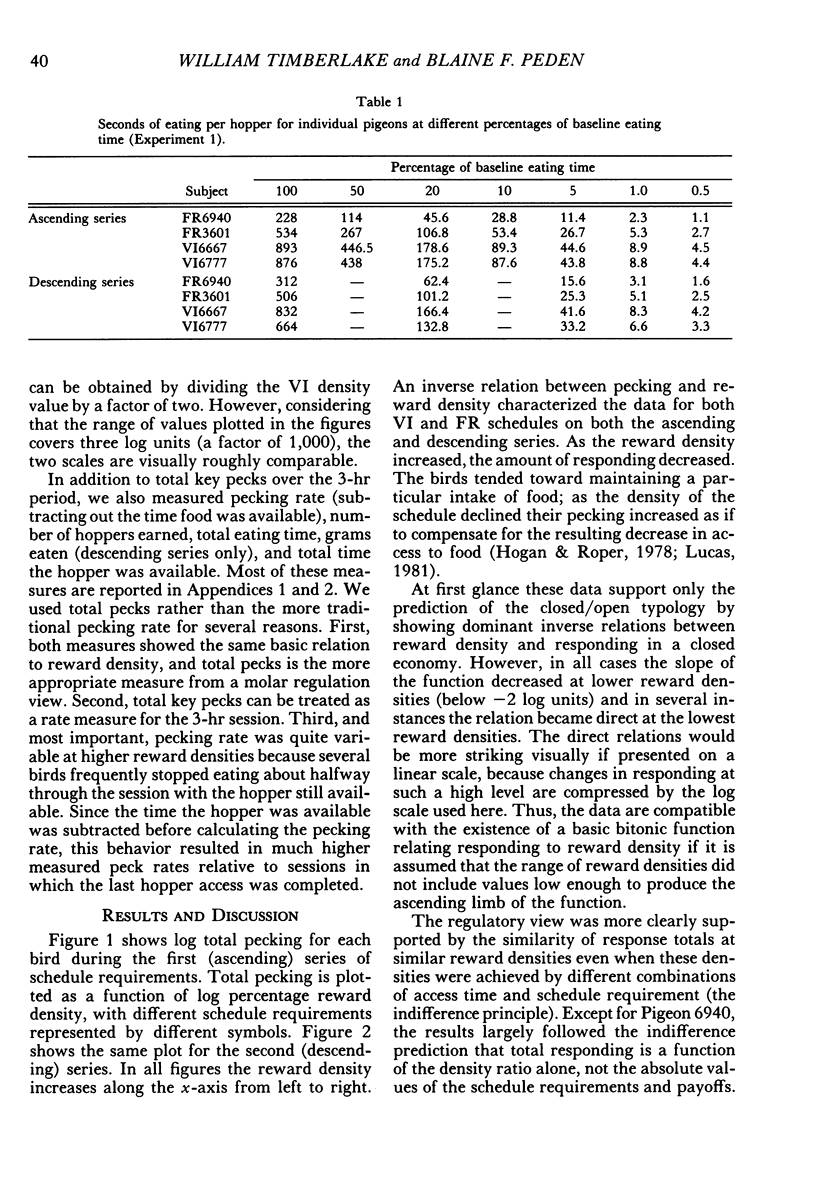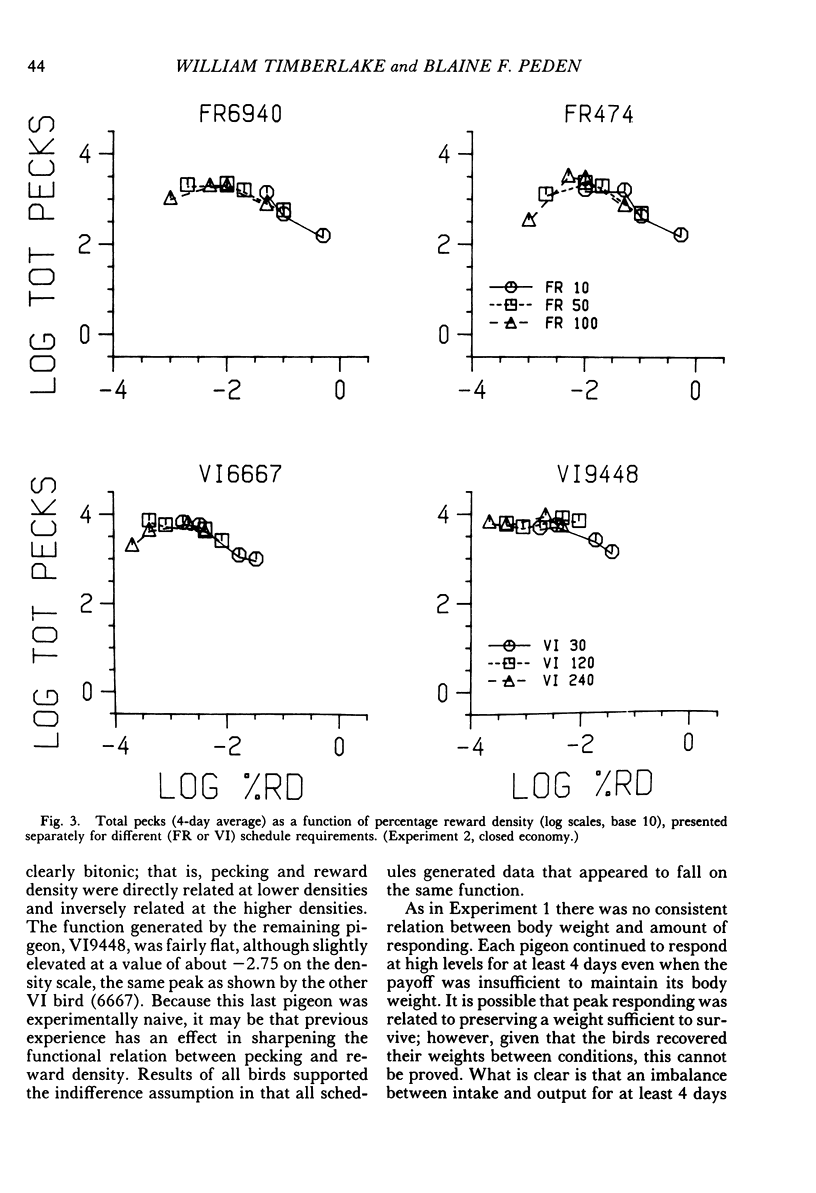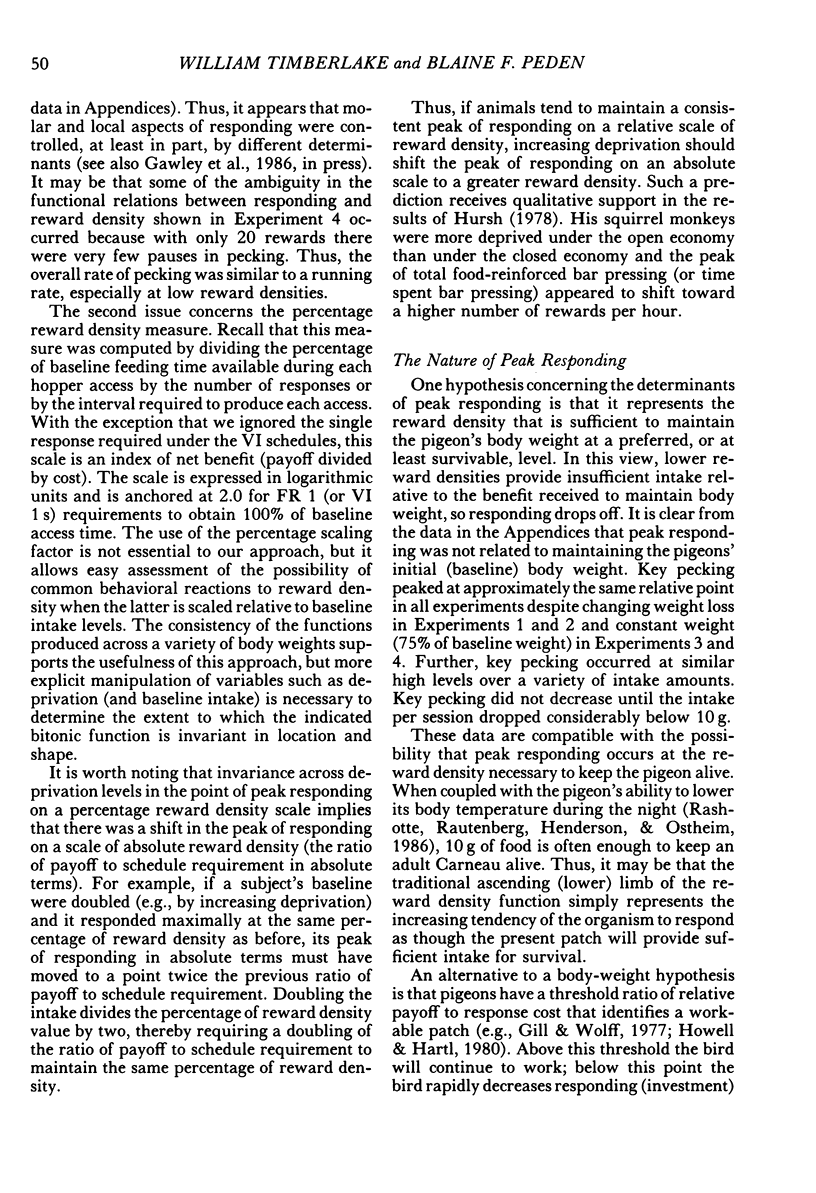Abstract
Open and closed economies have been assumed to produce opposite relations between responding and the programmed density of reward (the amount of reward divided by its cost). Experimental procedures that are treated as open economies typically dissociate responding and total reward by providing supplemental income outside the experimental session; procedures construed as closed economies do not. In an open economy responding is assumed to be directly related to reward density, whereas in a closed economy responding is assumed to be inversely related to reward density. In contrast to this predicted correlation between response-reward relations and type of economy, behavior regulation theory predicts both direct and inverse relations in both open and closed economies. Specifically, responding should be a bitonic function of reward density regardless of the type of economy and is dependent only on the ratio of the schedule terms rather than on their absolute size. These predictions were tested by four experiments in which pigeons' key pecking produced food on fixed-ratio and variable-interval schedules over a range of reward magnitudes and under several open- and closed-economy procedures. The results better supported the behavior regulation view by showing a general bitonic function between key pecking and food density in all conditions. In most cases, the absolute size of the schedule requirement and the magnitude of reward had no effect; equal ratios of these terms produced approximately equal responding.
Full text
PDF

























Selected References
These references are in PubMed. This may not be the complete list of references from this article.
- Baum W. M. Optimization and the matching law as accounts of instrumental behavior. J Exp Anal Behav. 1981 Nov;36(3):387–403. doi: 10.1901/jeab.1981.36-387. [DOI] [PMC free article] [PubMed] [Google Scholar]
- CATANIA A. C. Concurrent performances: a baseline for the study of reinforcement magnitude. J Exp Anal Behav. 1963 Apr;6:299–300. doi: 10.1901/jeab.1963.6-299. [DOI] [PMC free article] [PubMed] [Google Scholar]
- Catania A. C., Reynolds G. S. A quantitative analysis of the responding maintained by interval schedules of reinforcement. J Exp Anal Behav. 1968 May;11(3 Suppl):327–383. doi: 10.1901/jeab.1968.11-s327. [DOI] [PMC free article] [PubMed] [Google Scholar]
- Collier G. H., Johnson D. F., Hill W. L., Kaufman L. W. The economics of the law of effect. J Exp Anal Behav. 1986 Sep;46(2):113–136. doi: 10.1901/jeab.1986.46-113. [DOI] [PMC free article] [PubMed] [Google Scholar]
- Collier G., Hirsch E., Hamlin P. H. The ecological determinants of reinforcement in the rat. Physiol Behav. 1972 Nov-Dec;9(5):705–716. doi: 10.1016/0031-9384(72)90038-8. [DOI] [PubMed] [Google Scholar]
- Dougan J. D., McSweeney F. K. Variation in Herrnstein's r(o) as a function of alternative reinforcement rate. J Exp Anal Behav. 1985 Mar;43(2):215–223. doi: 10.1901/jeab.1985.43-215. [DOI] [PMC free article] [PubMed] [Google Scholar]
- Elliffe D., Davison M. Performance in continuously available multiple schedules. J Exp Anal Behav. 1985 Nov;44(3):343–353. doi: 10.1901/jeab.1985.44-343. [DOI] [PMC free article] [PubMed] [Google Scholar]
- Felton M., Lyon D. O. The post-reinforcement pause. J Exp Anal Behav. 1966 Mar;9(2):131–134. doi: 10.1901/jeab.1966.9-131. [DOI] [PMC free article] [PubMed] [Google Scholar]
- Fernie R. W. A device for measuring food-magazine behavior in the pigeon. J Exp Anal Behav. 1971 Nov;16(3):409–410. doi: 10.1901/jeab.1971.16-409. [DOI] [PMC free article] [PubMed] [Google Scholar]
- Gawley D. J., Timberlake W., Lucas G. A. Schedule constraint on the average drink burst and the regulation of wheel running and drinking in rats. J Exp Psychol Anim Behav Process. 1986 Jan;12(1):78–94. [PubMed] [Google Scholar]
- Gill C. O., Penney N. Penetration of bacteria into meat. Appl Environ Microbiol. 1977 Jun;33(6):1284–1286. doi: 10.1128/aem.33.6.1284-1286.1977. [DOI] [PMC free article] [PubMed] [Google Scholar]
- Green L., Kagel J. H., Battalio R. C. Consumption-leisure tradeoffs in pigeons: Effects of changing marginal wage rates by varying amount of reinforcement. J Exp Anal Behav. 1987 Jan;47(1):17–28. doi: 10.1901/jeab.1987.47-17. [DOI] [PMC free article] [PubMed] [Google Scholar]
- Hursh S. R. Behavioral economics. J Exp Anal Behav. 1984 Nov;42(3):435–452. doi: 10.1901/jeab.1984.42-435. [DOI] [PMC free article] [PubMed] [Google Scholar]
- Hursh S. R. Economic concepts for the analysis of behavior. J Exp Anal Behav. 1980 Sep;34(2):219–238. doi: 10.1901/jeab.1980.34-219. [DOI] [PMC free article] [PubMed] [Google Scholar]
- Hursh S. R. The economics of daily consumption controlling food- and water-reinforced responding. J Exp Anal Behav. 1978 May;29(3):475–491. doi: 10.1901/jeab.1978.29-475. [DOI] [PMC free article] [PubMed] [Google Scholar]
- Rachlin H., Baum W. M. Effects of alternative reinforcement: does the source matter? J Exp Anal Behav. 1972 Sep;18(2):231–241. doi: 10.1901/jeab.1972.18-231. [DOI] [PMC free article] [PubMed] [Google Scholar]
- Timberlake W. A temporal limit on the effect of future food on current performance in an analogue of foraging and welfare. J Exp Anal Behav. 1984 Mar;41(2):117–124. doi: 10.1901/jeab.1984.41-117. [DOI] [PMC free article] [PubMed] [Google Scholar]
- Timberlake W. Behavior regulation and learned performance: Some misapprehensions and disagreements. J Exp Anal Behav. 1984 May;41(3):355–375. doi: 10.1901/jeab.1984.41-355. [DOI] [PMC free article] [PubMed] [Google Scholar]
- Timberlake W., Gawley D. J., Lucas G. A. Time horizons in rats foraging for food in temporally separated patches. J Exp Psychol Anim Behav Process. 1987 Jul;13(3):302–309. [PubMed] [Google Scholar]
- Timberlake W. The application of the matching law to simple ratio schedules. J Exp Anal Behav. 1977 Jan;27(1):215–217. doi: 10.1901/jeab.1977.27-215. [DOI] [PMC free article] [PubMed] [Google Scholar]
- Williams B. A. Contrast, component duration, and the following schedule of reinforcement. J Exp Psychol Anim Behav Process. 1979 Oct;5(4):379–396. doi: 10.1037//0097-7403.5.4.379. [DOI] [PubMed] [Google Scholar]


